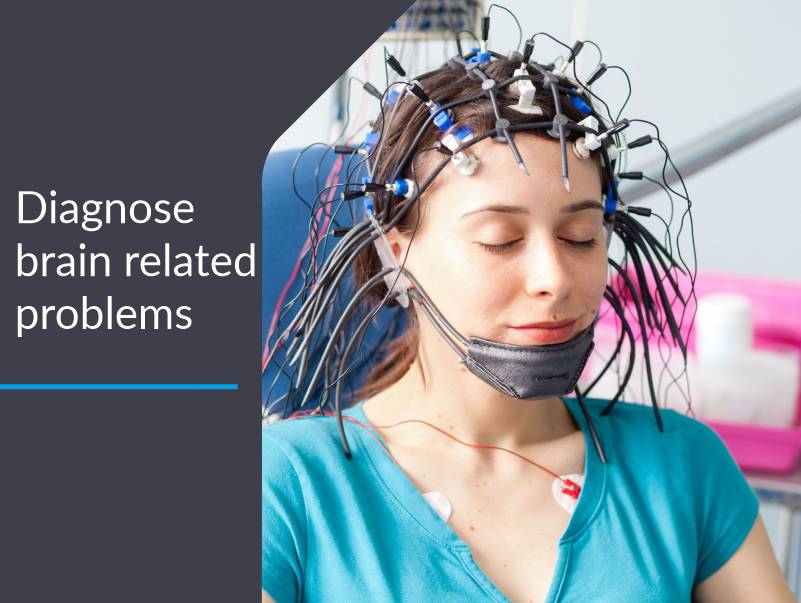
Generalized background slowing indicates diffuse cerebral dysfunction, which, similar to focal slowing, is also not specific as to cause. See Figure 54 for an example of focal temporal regional slowing, which also shows a “breach rhythm,” with focally elevated background amplitude as a result of a skull defect and previous surgery in this area. The various causes are too numerous to be comprehensive, but common examples include transient or permanent ischemia resulting from stroke, brain hemorrhage, tumors, traumatic injury, malformations of cortical development, nonstructural focal cerebral dysfunction corresponding to a focal epileptic focus, focal involvement of the cortex by neurodegeneration, arteriovenous malformations, and focal brain infection caused by bacterial cerebritis or viral encephalitis. Focal brain lesions of a variety of causes to cortex, underlying white matter, or both may induce focal slowing. When intermittent, focal slowing may indicate unveiling of subtle focal cerebral dysfunction owing to the effects of a sedating or hypnotic medication, although usually medication-induced slowing is generalized in nature. A variety of etiologies for focal cerebral dysfunction may be seen. Slowing may be intermittent or persistent, with more persistent or consistently slower activity generally indicating more severe underlying focal cerebral dysfunction. Nondirective meditation yields more marked changes in electrical brain wave activity associated with wakeful, relaxed attention, than just resting without any specific mental technique.Focal slow wave activity on the EEG is indicative of focal cerebral pathology of the underlying brain region. Instead of concentrating on getting away from stressful thought and emotions, you simple let them pass in an effortless way."

They cultivate the ability to tolerate the spontaneous wandering of the mind without getting too much involved. "These methods are often described as nondirective, because practitioners do not actively pursue a particular experience or state of mind. Several studies indicate better relaxation and stress management by meditation techniques where you refrain from trying to control the content of the mind. "These findings indicate that you step away from problem solving both when relaxing and during meditation," says Ellingsen. EEG showed few beta waves during meditation and resting. There was little delta during the relaxing and meditative tasks, confirming that nondirective meditation is different from sleep.īeta waves occur when the brain is working on goal-oriented tasks, such as planning a date or reflecting actively over a particular issue. It probably represents a kind of mental processing that connects various experiences and emotional residues, puts them into perspective and lays them to rest."ĭelta waves are characteristic of sleep. "This default activity of the brain is often underestimated. "Spontaneous wandering of the mind is something you become more aware of and familiar with when you meditate," continues Ellingsen, who is an experienced practitioner. Mason and co-workers at Dartmouth College NH suggest that the normal resting state of the brain is a silent current of thoughts, images and memories that is not induced by sensory input or intentional reasoning, but emerges spontaneously "from within."

"The amount of alpha waves increases when the brain relaxes from intentional, goal-oriented tasks.This is a sign of deep relaxation, - but it does not mean that the mind is void."

"This wave type has been used as a universal sign of relaxation during meditation and other types of rest," comments Professor Øyvind Ellingsen from NTNU. The abundance and location of slow to fast electrical brain waves (delta, theta, alpha, beta) provide a good indication of brain activity.ĭuring meditation, theta waves were most abundant in the frontal and middle parts of the brain. They were asked to rest, eyes closed, for 20 minutes, and to meditate for another 20 minutes, in random order. Participants were experienced practitioners of Acem Meditation, a nondirective method developed in Norway. EEG electrodes were placed in standard locations of the scalp using a custom-made hat The study monitored the frequency and location of electrical brain waves through the use of EEG (electroencephalography). Whether we are mentally active, resting or asleep, the brain always has some level of electrical activity. Lagopoulos is the principal investigator of a joint study between his university and researchers from the Norwegian University of Science and Technology (NTNU) on changes in electrical brain activity during nondirective meditation. "Given the popularity and effectiveness of meditation as a means of alleviating stress and maintaining good health, there is a pressing need for a rigorous investigation of how it affects brain function," says Professor Jim Lagopoulos of Sydney University, Australia.


 0 kommentar(er)
0 kommentar(er)
